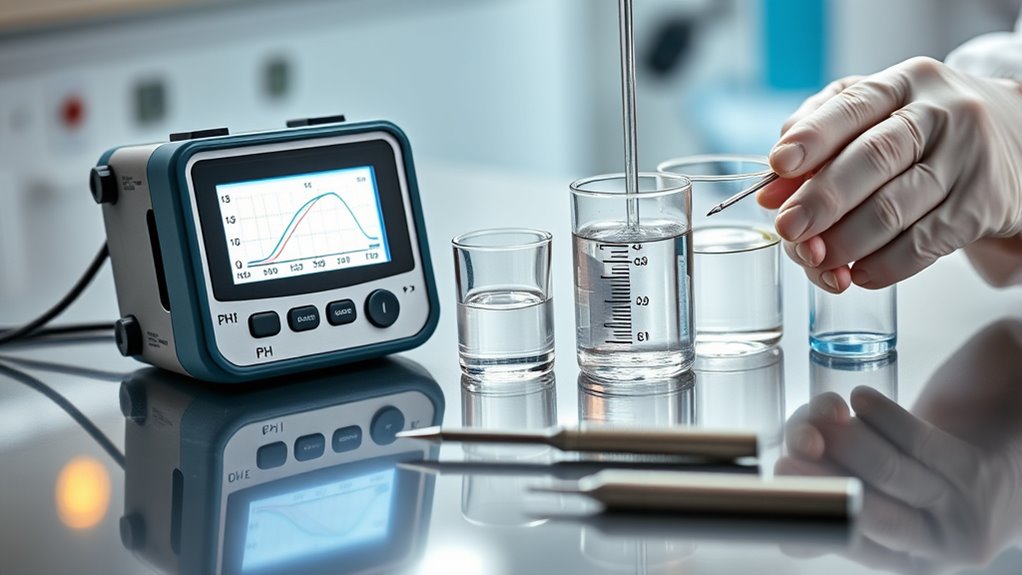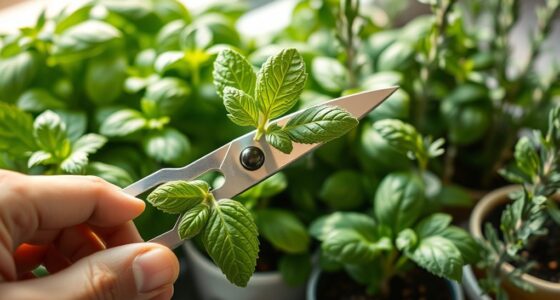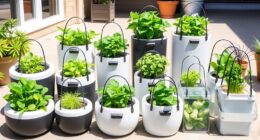To calibrate your pH and EC meters, start by gathering fresh calibration solutions that match your target points and guarantee everything is clean. Rinse your sensors with distilled water. For pH, immerse the probe in pH buffers (7, then 4 or 10) and adjust accordingly. For EC, dip the probe into standard solutions and calibrate the device. Regular checks and proper maintenance help keep your measurements accurate—continue further to learn more about ensuring precision.
Key Takeaways
- Rinse the electrodes with distilled water before immersing them in calibration solutions to prevent contamination.
- Calibrate the pH meter using standard buffers at pH 4, 7, and 10, adjusting the calibration screw at each point.
- Calibrate the EC meter with known standard solutions, adjusting the calibration knob until readings match the standards.
- Verify calibration accuracy by testing with fresh buffer or standard solutions, re-calibrating if readings are outside acceptable ranges.
- Store sensors properly, perform regular cleaning, and re-calibrate weekly or more frequently for consistent accuracy.
Gathering the Necessary Calibration Materials
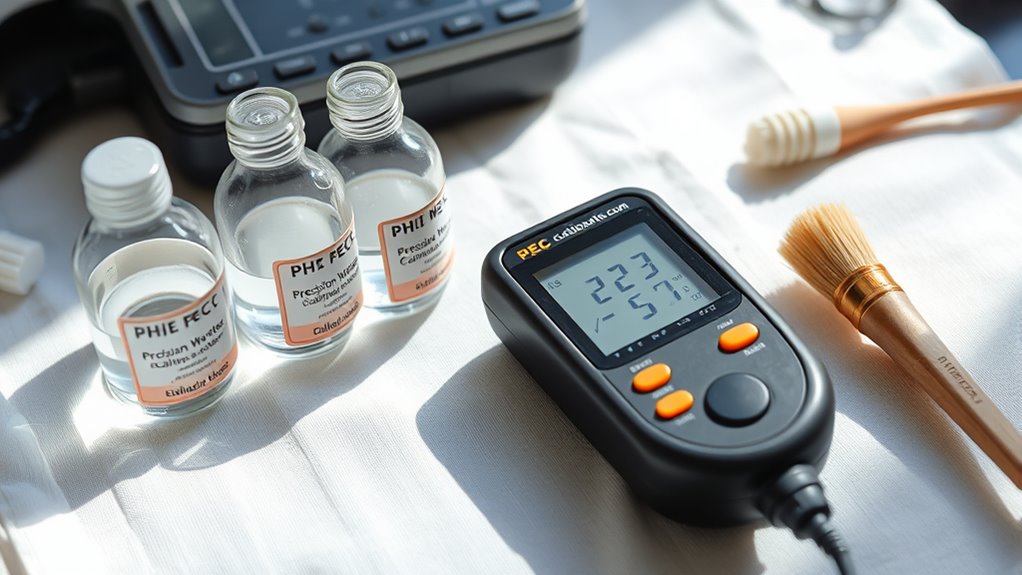
Before you begin calibrating your pH and EC meters, it is vital to gather all the necessary materials. Proper sensor maintenance starts with having the right supplies on hand, guaranteeing accurate readings. You’ll need calibration solutions specific to your meters, usually pH buffer solutions and EC standards. Keep in mind that regular calibration frequency depends on your usage but should generally be performed weekly or after sensor maintenance. Having clean, distilled water for rinsing your sensors is essential to prevent contamination. Make sure you also have clean containers for solutions and calibration logs to record adjustments. Gathering these materials beforehand helps streamline the process, reduces errors, and guarantees your sensors stay accurate over time. Proper preparation is key to reliable calibration. Additionally, understanding the design features of your meters can help ensure proper handling and calibration procedures.
Preparing Your Calibration Solutions
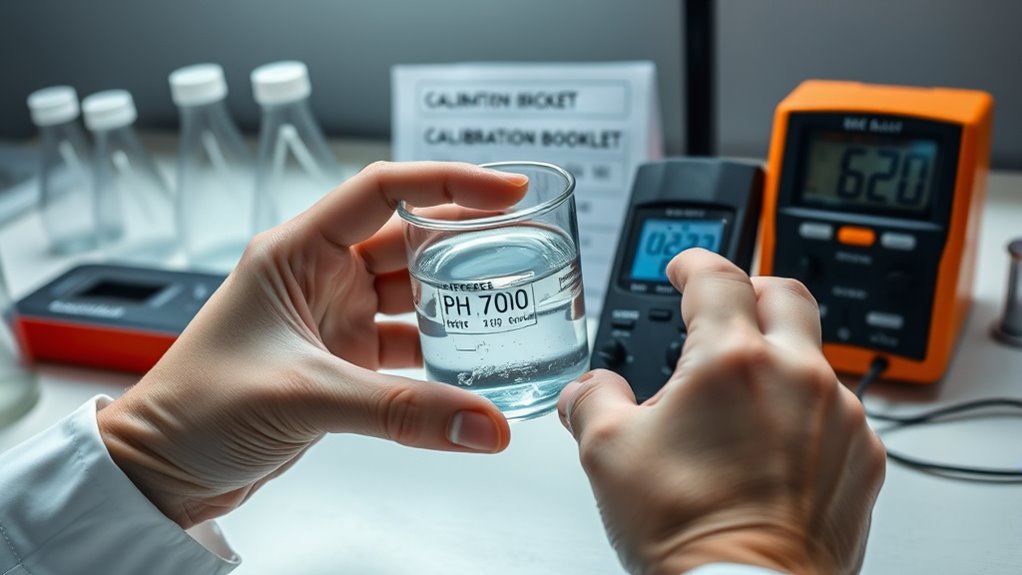
Once you’ve gathered your calibration materials, the next step is preparing your calibration solutions. You’ll need fresh, accurate pH buffer solutions and EC standard solutions to guarantee precise calibration. Using proper storage methods helps maintain solution integrity over time.
Preparing fresh, accurate calibration solutions ensures precise and reliable measurements.
- Select the right pH buffer: Use a pH buffer that matches your target calibration point, like pH 4, 7, or 10. Make sure it’s fresh and properly stored.
- Prepare your EC standard solution: Use a reliable EC standard solution, ensuring it’s within the calibration range of your meter.
- Check solution temperature: Both pH buffer and EC solutions should be at room temperature for accurate readings.
- Label and store: Clearly label your solutions and keep them sealed to prevent contamination before use.
Calibrating the Ph Meter: Step-By-Step

To guarantee accurate pH measurements, you need to carefully calibrate your pH meter by following a precise step-by-step process. Begin by rinsing the electrode with distilled water to remove contaminants. Then, immerse it in your pH calibration buffer—usually pH 7.0—and allow the reading to stabilize. Adjust the calibration screw until the meter reads correctly, ensuring pH correction is precise. Next, rinse again and repeat with a second buffer, such as pH 4.0 or 10.0, for fine-tuning. Proper calibration is essential to maintain electrode longevity and ensure consistent results. Regular calibration also minimizes the need for pH correction later, saving you time and improving measurement accuracy. Incorporating proper maintenance practices, such as cleaning and storing the electrode correctly, can extend its lifespan and reliability. Follow these steps consistently for reliable pH readings.
Calibrating the EC Meter: Step-by-Step
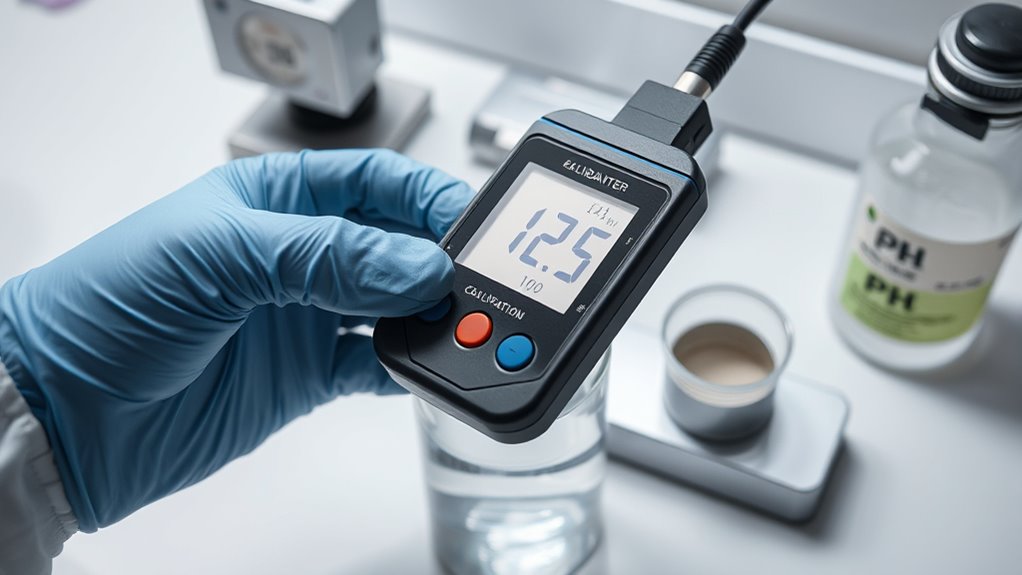
Calibrating your EC meter accurately is essential for reliable conductivity measurements. Proper EC meter maintenance guarantees consistent results, and adhering to the correct calibration frequency keeps your readings precise. Here’s how to calibrate step-by-step:
Regular calibration ensures accurate EC readings and prolongs your meter’s lifespan.
- Rinse your EC probe with distilled water to remove residues.
- Immerse it in a calibration solution with a known EC value.
- Adjust the calibration knob or settings until the display matches the solution’s value.
- Rinse again and test with a different standard solution for confirmation.
- Pay attention to measurement accuracy to ensure your calibration process is effective.
Regular calibration helps maintain accuracy and extends your meter’s lifespan. Remember, calibration frequency depends on usage, but doing it weekly or bi-weekly is a good rule of thumb. This process ensures your EC measurements stay reliable and your readings precise.
Verifying Calibration Accuracy
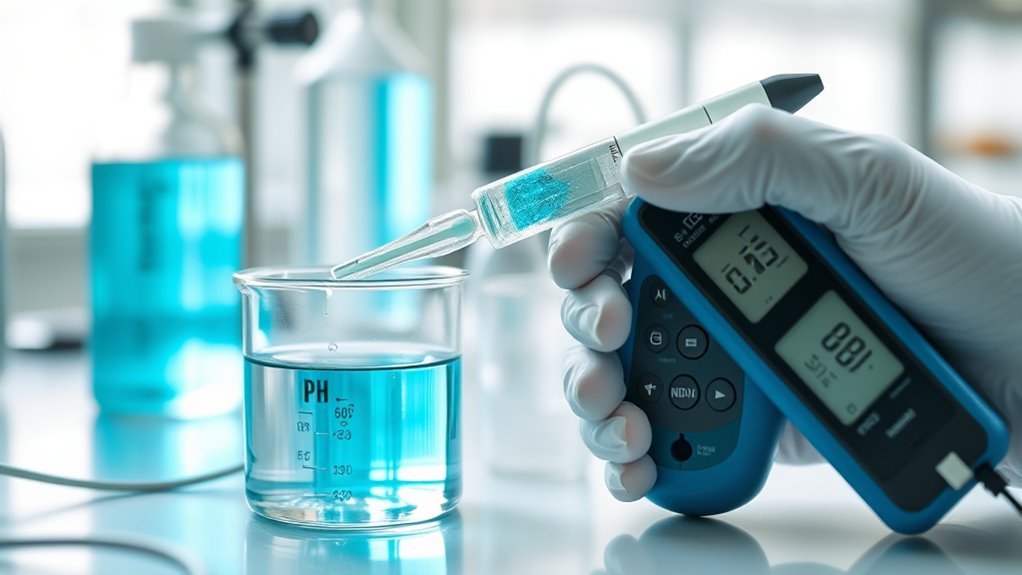
After calibrating your EC or pH meter, it’s imperative to verify that the calibration is accurate before taking essential measurements. This step ensures your sensor’s longevity and boosts your user calibration confidence. To do this, test the meter with a calibration standard or buffer solution that matches your calibration point. If the readings fall within the acceptable range, your calibration is accurate. If not, re-calibrate or adjust as needed. Regular verification helps catch any drift in sensor performance early, preventing measurement errors. It also reassures you that your readings are reliable, which is critical for consistent data quality. By confirming calibration accuracy, you maintain your meter’s best functioning and ensure trustworthy results every time. Additionally, understanding the importance of color accuracy in related equipment can help you interpret your measurements more effectively.
Maintaining Your Meters for Long-Term Reliability
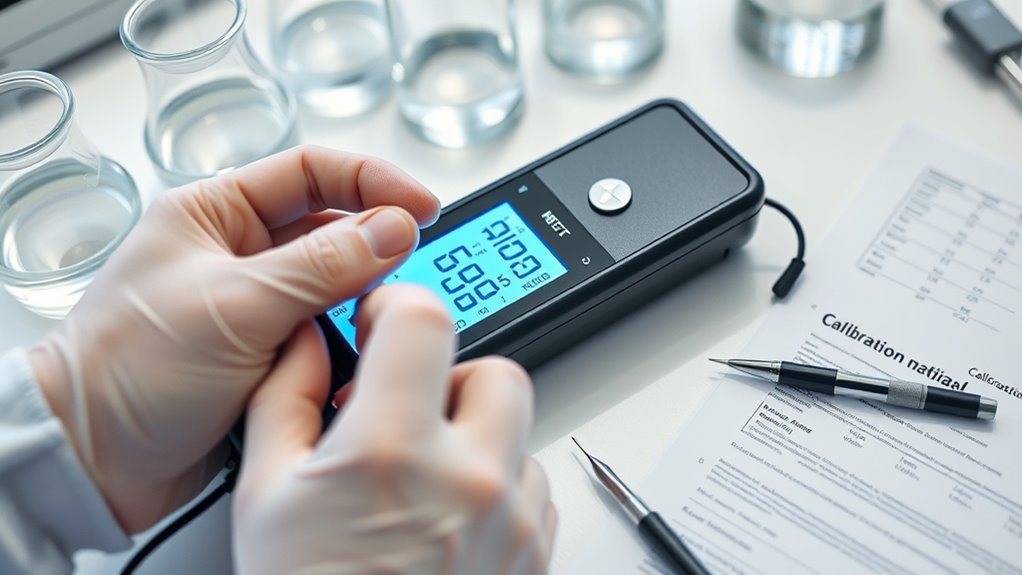
To keep your pH and EC meters reliable over time, proper storage and regular maintenance are essential. Store your meters in the recommended solutions and check them periodically for any issues. Staying consistent with these practices guarantees accurate readings and extends your meters’ lifespan. Using an eye patch regularly can also help maintain the appearance of the skin around your eyes, ensuring long-term benefits.
Proper Storage Practices
Proper storage is essential to keep your pH and EC meters accurate and reliable over time. Poor storage can lead to sensor degradation and inaccurate readings. To ensure longevity, follow these storage precautions:
- Always rinse sensors with distilled water after use and dry gently.
- Store pH meters in a storage solution or buffer solution recommended by the manufacturer.
- Keep the probes capped or in a protective container to prevent drying out.
- Avoid exposing meters to extreme temperatures or direct sunlight.
Maintaining proper storage habits helps reduce calibration frequency and prevents sensor drift. Regularly check stored meters for signs of damage or drying out. Following these practices preserves your meters’ accuracy, saving you time and money in the long run.
Regular Maintenance Checks
Regular maintenance checks are essential to guarantee your pH and EC meters remain accurate and dependable over time. You should regularly inspect and clean the sensors to prevent buildup that can skew readings. Sensor cleaning involves gently rinsing with distilled water after each use and avoiding harsh abrasives. It’s also important to follow proper calibration frequency—calibrating your meters weekly or after any significant use ensures consistent accuracy. During maintenance, verify that the sensors are free of debris and properly calibrated, adjusting as needed. Consistent sensor cleaning and sticking to a routine calibration schedule help prolong your meters’ lifespan and maintain their precision. Regular checks save you time and money by preventing measurement errors and ensuring reliable data for your applications. Additionally, using the right oil for your equipment can prevent contamination and ensure the longevity of your sensors and other components.
Troubleshooting Common Calibration Issues
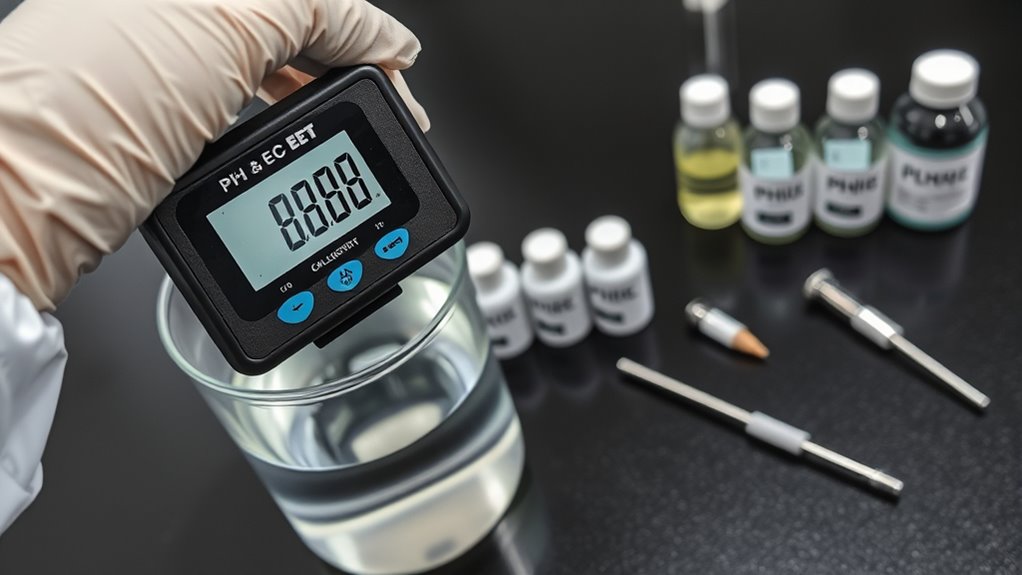
Calibration drift can lead to inaccurate readings, so it’s important to verify your meters regularly. Compatibility issues with reagents may also cause calibration errors, especially if you’re using outdated or incompatible solutions. By understanding these common causes, you can quickly identify and fix calibration problems to ensure reliable measurements. Additionally, proper maintenance practices can help prevent calibration issues from occurring in the first place.
Calibration Drift Causes
Calibration drift occurs when pH or EC readings gradually become inaccurate over time, even if your meter hasn’t been physically damaged. This often results from sensor degradation or environmental interference affecting measurements. Over time, sensors wear out or become less responsive, leading to drift. Environmental factors like temperature fluctuations, electrical noise, or chemical contamination can also interfere with accuracy. To avoid calibration issues, watch for these common causes: 1. Sensor aging and wear 2. Exposure to harsh chemicals 3. Temperature fluctuations during measurements 4. External electrical interference. Regular calibration, proper storage, and avoiding extreme conditions will help minimize drift and keep your meters reliable over time. Additionally, understanding the importance of HEPA Filtration and other air purification technologies can help in maintaining an optimal indoor environment.
Reagent Compatibility Problems
Reagent compatibility issues can cause calibration errors by introducing contaminants or chemical imbalances that affect your meter’s readings. Reagent incompatibility occurs when calibration solutions are mixed with incompatible chemicals, leading to inaccurate results. Additionally, poor storage solution stability can degrade reagents over time, reducing their effectiveness and skewing calibration. Always guarantee you use reagents specifically designed for your pH or EC meters and avoid mixing different brands or types unless confirmed compatible. Proper storage in sealed, cool, and dark conditions helps maintain reagent stability. If you notice inconsistent calibration results, check for signs of reagent degradation or contamination. Regularly replacing expired or compromised solutions is essential to prevent reagent incompatibility from impacting measurement accuracy. Understanding how reagents interact can further help prevent calibration issues and ensure reliable readings.
Tips for Accurate and Consistent Readings
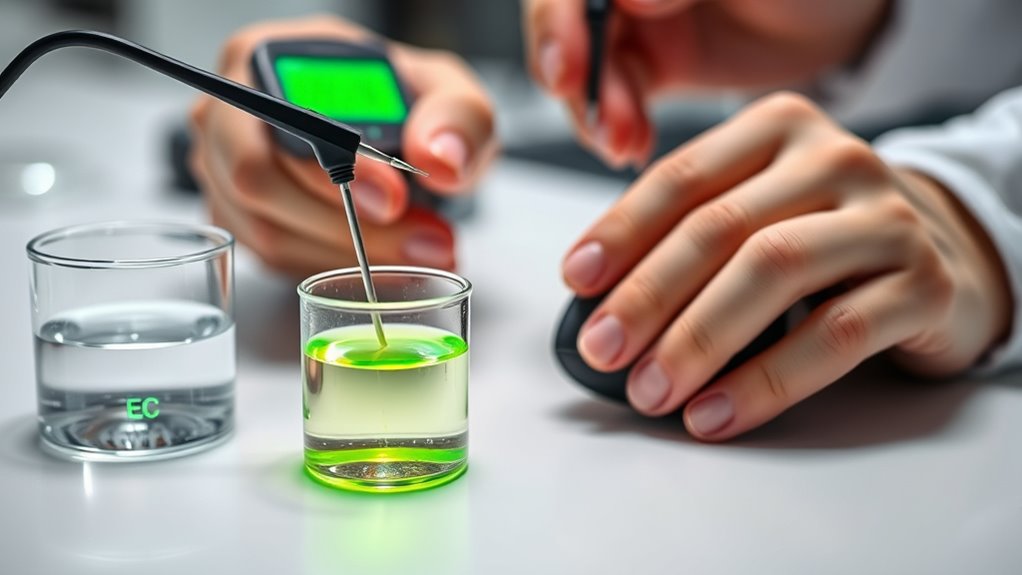
To guarantee your pH and EC meters provide reliable readings, it’s essential to follow some practical tips that promote accuracy and consistency. Proper user training ensures you handle sensors correctly, extending sensor longevity and preventing damage. Always rinse sensors thoroughly after each use to avoid contamination. Store your meters in recommended storage solutions to maintain calibration stability. Consistent measurement techniques, like gentle stirring and waiting for stabilization, help reduce variability. Avoid touching sensor surfaces with your hands or using rough tools. Regularly check for signs of wear, and replace sensors when needed. Additionally, understanding environmental considerations can help you select appropriate locations and minimize your impact on nature. These practices keep your equipment in top shape, ensuring accurate readings over time and minimizing measurement errors.
Regular Calibration Schedule and Best Practices
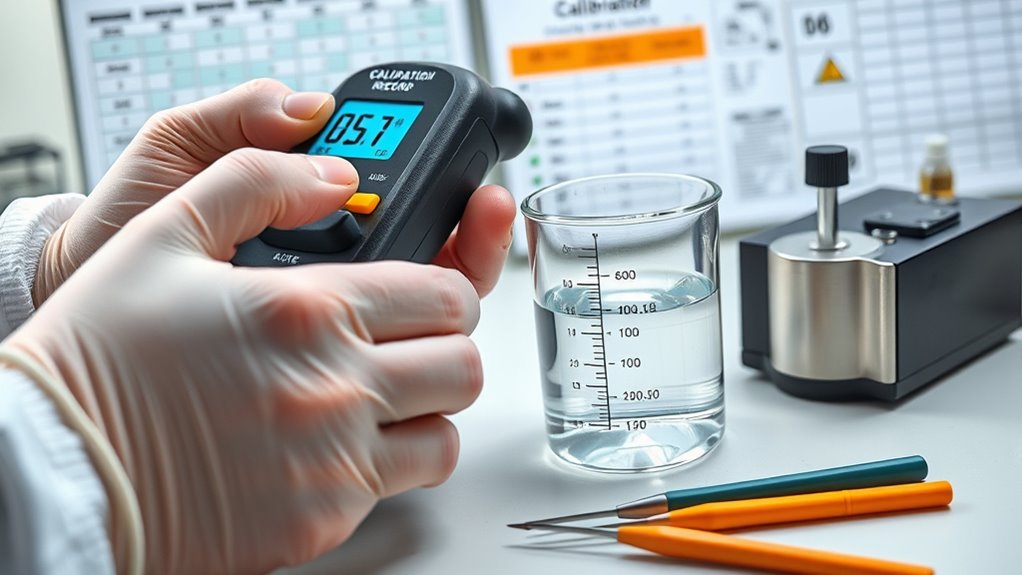
Establishing a regular calibration schedule guarantees your pH and EC meters stay accurate over time. Consistent calibration helps maximize sensor lifespan and ensures reliable readings. You should calibrate your meters at least weekly if used frequently, or more often if you notice drifting measurements. Proper calibration frequency depends on your usage, sample conditions, and device quality. Keep a record of calibration dates to track performance and identify when sensors need replacement. Avoid skipping calibrations, as neglecting this can lead to inaccurate data and reduce sensor lifespan. Regular calibration not only maintains measurement precision but also prolongs your meters’ durability. Incorporating best practices such as using fresh calibration solutions and handling sensors gently to ensure peak performance over their lifespan. Additionally, understanding Forsale 100 can help you find affordable calibration supplies and accessories to support your maintenance routine.
Frequently Asked Questions
How Often Should I Calibrate My Ph and EC Meters?
You should follow a regular maintenance schedule to keep your pH and EC meters accurate. Calibration frequency depends on usage and conditions but generally, calibrate your meters at least once a month. If you use them daily or in harsh environments, consider calibrating weekly. Regular calibration ensures precise readings, prevents errors, and extends your meters’ lifespan. Staying consistent with calibration helps maintain reliable measurements for ideal plant health and water quality.
Can I Use Tap Water for Calibration Solutions?
You might be tempted to use tap water for calibration solutions, but it can jeopardize calibration accuracy. Tap water contains minerals and impurities that can skew readings, leading to inaccurate results. For precise calibration, it’s best to use distilled or deionized water. This ensures your pH and EC meters stay accurate and reliable, preventing errors in your measurements and maintaining consistent performance over time.
What Should I Do if Readings Are Inconsistent After Calibration?
If your readings are inconsistent after calibration, you should troubleshoot the issues first. Check for dirt or residue on the electrodes and clean them thoroughly. Next, verify your calibration solutions are fresh and correctly prepared. If problems persist, perform a calibration adjustment, re-calibrating the meter carefully. Consistent inconsistencies may indicate a faulty electrode or meter, so consider replacing parts or consulting the manufacturer for further troubleshooting.
Are There Differences in Calibration Procedures for Different Meter Brands?
You might notice differences in calibration procedures across brands due to brand-specific calibration requirements and device compatibility. Each brand often provides tailored instructions to guarantee accurate readings, so it’s crucial to follow the manufacturer’s guidelines. Always check if your calibration solutions and accessories are compatible with your specific meter model. Adapting to these brand-specific calibration steps guarantees reliable results and prolongs your device’s lifespan.
How Do Temperature Variations Affect Calibration Accuracy?
Did you know that temperature fluctuations can cause up to a 2-3% error in pH and EC readings? Temperature variations greatly impact calibration accuracy, so you need to use temperature compensation features on your meters. Environmental factors like ambient temperature and water temperature influence measurements, making it essential to calibrate in consistent conditions or adjust readings accordingly. This ensures your results stay precise despite changing environmental factors.
Conclusion
Just like a skilled sailor trusts their compass, regular calibration keeps your pH and EC meters sailing smoothly. By following these steps, you guarantee accurate readings as steady as a lighthouse guiding ships through the night. Keep your tools in top shape, and you’ll navigate the waters of testing with confidence and precision. Remember, consistent care transforms a simple instrument into a trusty partner—your own personal Polaris in the world of measurement.
